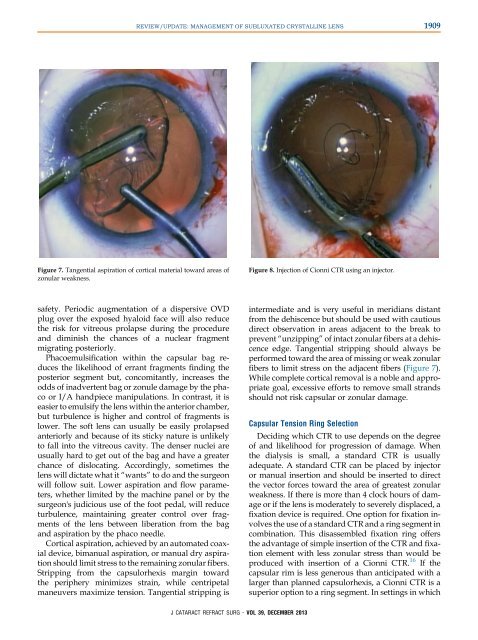Management of Subluxated Lens
Management of Subluxated Lens
Management of Subluxated Lens
You also want an ePaper? Increase the reach of your titles
YUMPU automatically turns print PDFs into web optimized ePapers that Google loves.
REVIEW/UPDATE: MANAGEMENT OF SUBLUXATED CRYSTALLINE LENS<br />
1909<br />
Figure 7. Tangential aspiration <strong>of</strong> cortical material toward areas <strong>of</strong><br />
zonular weakness.<br />
Figure 8. Injection <strong>of</strong> Cionni CTR using an injector.<br />
safety. Periodic augmentation <strong>of</strong> a dispersive OVD<br />
plug over the exposed hyaloid face will also reduce<br />
the risk for vitreous prolapse during the procedure<br />
and diminish the chances <strong>of</strong> a nuclear fragment<br />
migrating posteriorly.<br />
Phacoemulsification within the capsular bag reduces<br />
the likelihood <strong>of</strong> errant fragments finding the<br />
posterior segment but, concomitantly, increases the<br />
odds <strong>of</strong> inadvertent bag or zonule damage by the phaco<br />
or I/A handpiece manipulations. In contrast, it is<br />
easier to emulsify the lens within the anterior chamber,<br />
but turbulence is higher and control <strong>of</strong> fragments is<br />
lower. The s<strong>of</strong>t lens can usually be easily prolapsed<br />
anteriorly and because <strong>of</strong> its sticky nature is unlikely<br />
to fall into the vitreous cavity. The denser nuclei are<br />
usually hard to get out <strong>of</strong> the bag and have a greater<br />
chance <strong>of</strong> dislocating. Accordingly, sometimes the<br />
lens will dictate what it “wants” to do and the surgeon<br />
will follow suit. Lower aspiration and flow parameters,<br />
whether limited by the machine panel or by the<br />
surgeon's judicious use <strong>of</strong> the foot pedal, will reduce<br />
turbulence, maintaining greater control over fragments<br />
<strong>of</strong> the lens between liberation from the bag<br />
and aspiration by the phaco needle.<br />
Cortical aspiration, achieved by an automated coaxial<br />
device, bimanual aspiration, or manual dry aspiration<br />
should limit stress to the remaining zonular fibers.<br />
Stripping from the capsulorhexis margin toward<br />
the periphery minimizes strain, while centripetal<br />
maneuvers maximize tension. Tangential stripping is<br />
intermediate and is very useful in meridians distant<br />
from the dehiscence but should be used with cautious<br />
direct observation in areas adjacent to the break to<br />
prevent “unzipping” <strong>of</strong> intact zonular fibers at a dehiscence<br />
edge. Tangential stripping should always be<br />
performed toward the area <strong>of</strong> missing or weak zonular<br />
fibers to limit stress on the adjacent fibers (Figure 7).<br />
While complete cortical removal is a noble and appropriate<br />
goal, excessive efforts to remove small strands<br />
should not risk capsular or zonular damage.<br />
Capsular Tension Ring Selection<br />
Deciding which CTR to use depends on the degree<br />
<strong>of</strong> and likelihood for progression <strong>of</strong> damage. When<br />
the dialysis is small, a standard CTR is usually<br />
adequate. A standard CTR can be placed by injector<br />
or manual insertion and should be inserted to direct<br />
the vector forces toward the area <strong>of</strong> greatest zonular<br />
weakness. If there is more than 4 clock hours <strong>of</strong> damage<br />
or if the lens is moderately to severely displaced, a<br />
fixation device is required. One option for fixation involves<br />
the use <strong>of</strong> a standard CTR and a ring segment in<br />
combination. This disassembled fixation ring <strong>of</strong>fers<br />
the advantage <strong>of</strong> simple insertion <strong>of</strong> the CTR and fixation<br />
element with less zonular stress than would be<br />
produced with insertion <strong>of</strong> a Cionni CTR. 16 If the<br />
capsular rim is less generous than anticipated with a<br />
larger than planned capsulorhexis, a Cionni CTR is a<br />
superior option to a ring segment. In settings in which<br />
J CATARACT REFRACT SURG - VOL 39, DECEMBER 2013


